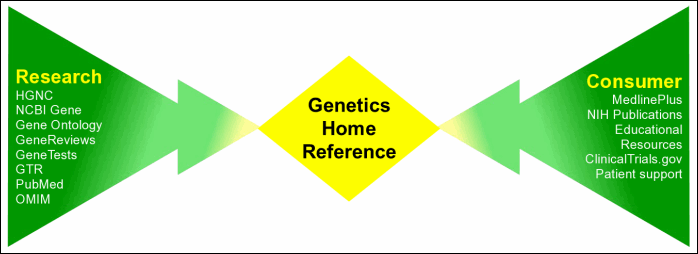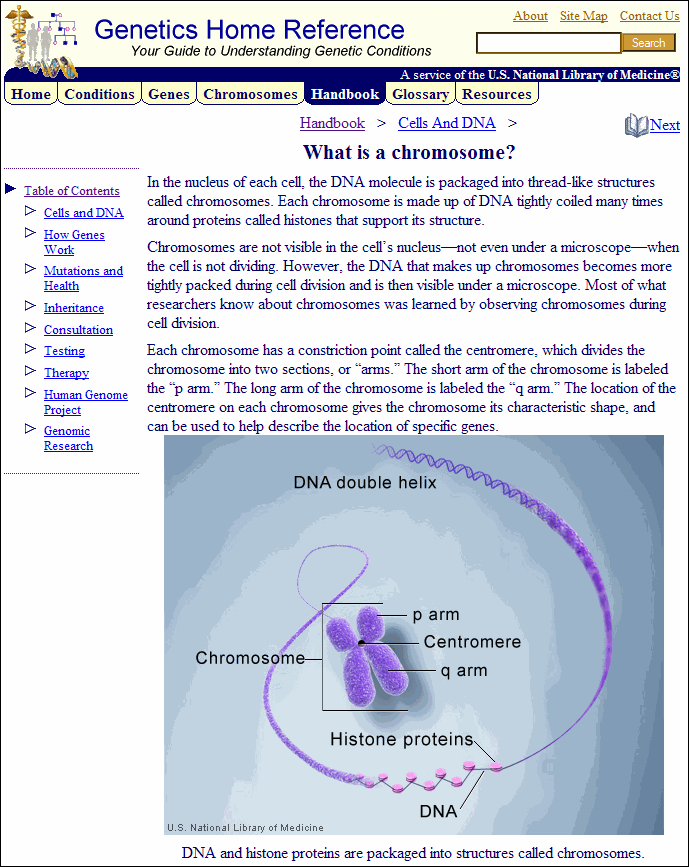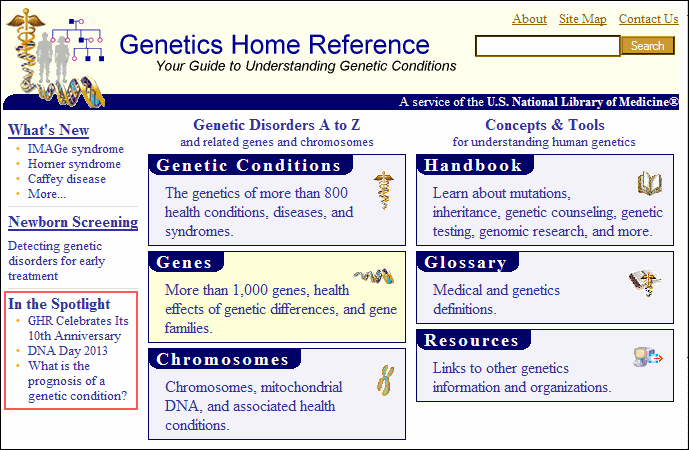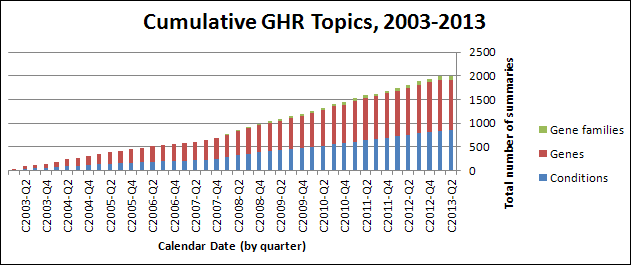



Table of Contents: 2013 MARCH–APRIL No. 391
Morrison S. Genetics Home Reference Celebrates Its 10th Anniversary. NLM Tech Bull. 2013 Mar-Apr;(391):e8.
The U.S. National Library of Medicine (NLM) launched the Genetics Home Reference (GHR) Web site on April 25, 2003 as a new consumer health information resource focused on human genetics.
The creation of GHR coincided with the completion of the Human Genome Project, a 13-year international effort to map the entire human genome. With so much rich data emerging from the Human Genome Project, the NLM wanted to create a bridge connecting the technical aspects of genomic research with the public’s interest in human genetics and health (see Figure 1).
 Figure 1: GHR serves as a bridge between research and consumer resources about human genetics.
Figure 1: GHR serves as a bridge between research and consumer resources about human genetics.GHR provides consumer-friendly information about genetic conditions and their related genes and chromosomes. This resource was designed for the public, including patients and their families, students, educators, and journalists. It is also used by healthcare professionals. Summaries are written in lay language by Library staff, and each is reviewed by an expert in human genetics before being posted to GHR and again with each substantive update.
Expanding Content
A decade ago, the GHR Web site began with 19 condition summaries and 16 gene descriptions. Since then, the content of the Web site has grown both in volume and in scope.
Among the first additions to the GHR Web site were summaries of conditions caused by chromosomal changes, such as Down syndrome, and information about each human chromosome. Soon after, several dozen conditions detectable through newborn screening were added to the Web site. In 2008, GHR introduced a summary of mitochondrial DNA (mtDNA) and mitochondrial conditions, including Leigh syndrome. A few years later the resource began including more common and complex conditions with a genetic component, such as multiple sclerosis and Crohn disease.
In addition to expanding content related to genetic conditions, GHR has also added new features and background information to help users understand the complexities of human genetics. A multi-chapter primer called the "Help Me Understand Genetics" Handbook (see Figure 2) provides an illustrated introduction to fundamental topics in human genetics. The Handbook started with basic explanations of mutations, inheritance, genetic testing, and gene therapy, and has grown to include information about complex inheritance, diagnosis and treatment of genetic disorders, and genomic research that has occurred since the completion of the Human Genome Project.
 Figure 2: A sample from GHR's Handbook, "Help Me Understand Genetics."
Figure 2: A sample from GHR's Handbook, "Help Me Understand Genetics."GHR also offers a glossary of genetic and medical terms, as well as an extensive list of other trusted online resources categorized by subject and audience.
Adding Other New Features
The GHR team has made efforts to educate the public about genetics via its Information Rx initiative. This free resource, which first became available in 2006, enables healthcare professionals to point their patients to reliable health information on the Internet. The program provides "Information Rx" prescription pads that direct patients to the GHR Web site for an explanation of genetic disorders, newborn screening, and related topics. An analysis of the program (Beaudoin et al., 2011) found that it supplemented healthcare providers’ advice and helped improve understanding of genetic conditions.
GHR’s In the Spotlight feature (see Figure 3), which also began in 2006 and is available on the Web site’s homepage, highlights important observances and discoveries in the field of human genetics and draws attention to useful learning tools and clinical resources. Spotlight topics have included newborn screening, family history, direct-to-consumer genetic testing, and Rare Disease Day.
 Figure 3: The In the Spotlight feature on GHR’s homepage highlights important information and events.
Figure 3: The In the Spotlight feature on GHR’s homepage highlights important information and events.GHR currently offers more than 2,000 total summaries of genetic information, comprising more than 850 genetic conditions, more than 1,060 genes, about 80 gene families, and all 24 human chromosomes plus mitochondrial DNA. This information has been reviewed by about 650 genetics experts worldwide. "Help Me Understand Genetics" has expanded to more than 70 pages and several dozen illustrations in nine chapters. New information is added regularly as the GHR Web site keeps growing (see Figure 4).
 Figure 4: Cumulative GHR topics over the past decade.
Figure 4: Cumulative GHR topics over the past decade.GHR continues to be an important and useful health information resource, currently receiving about 43,000 visitors per day and 39 million hits per month (see Figure 5).
 Figure 5: GHR Web traffic over the past decade.
Figure 5: GHR Web traffic over the past decade.GHR offers an RSS feed for notification about new topics on the Web site. Additionally, GHR provides an API page with information about creating links and tools for downloading GHR data in XML format.
The GHR team will continue adding new content to the Web site. In addition to rare disorders with Mendelian inheritance, the Web site will increasingly cover common and complex conditions that have a genetic component.
GHR is an active member of the genetics and bioinformatics communities. The Web site provides links to and from a wide variety of other resources, including the Genetic Testing Registry, OMIM, and the Genetic and Rare Diseases Information Center, and is always looking to coordinate with new partners. GHR staff are also working to map each GHR condition to SNOMED CT, and in collaboration with MedlinePlus Connect will make GHR content accessible from electronic health records. Additionally, terms from GHR are being integrated into the forthcoming 2014 MeSH vocabulary.
The GHR team welcomes feedback and suggestions for future content. A "Contact Us" link is available at the top of each page on the Web site.
By
Stephanie Morrison
Lister Hill National Center for Biomedical Communications